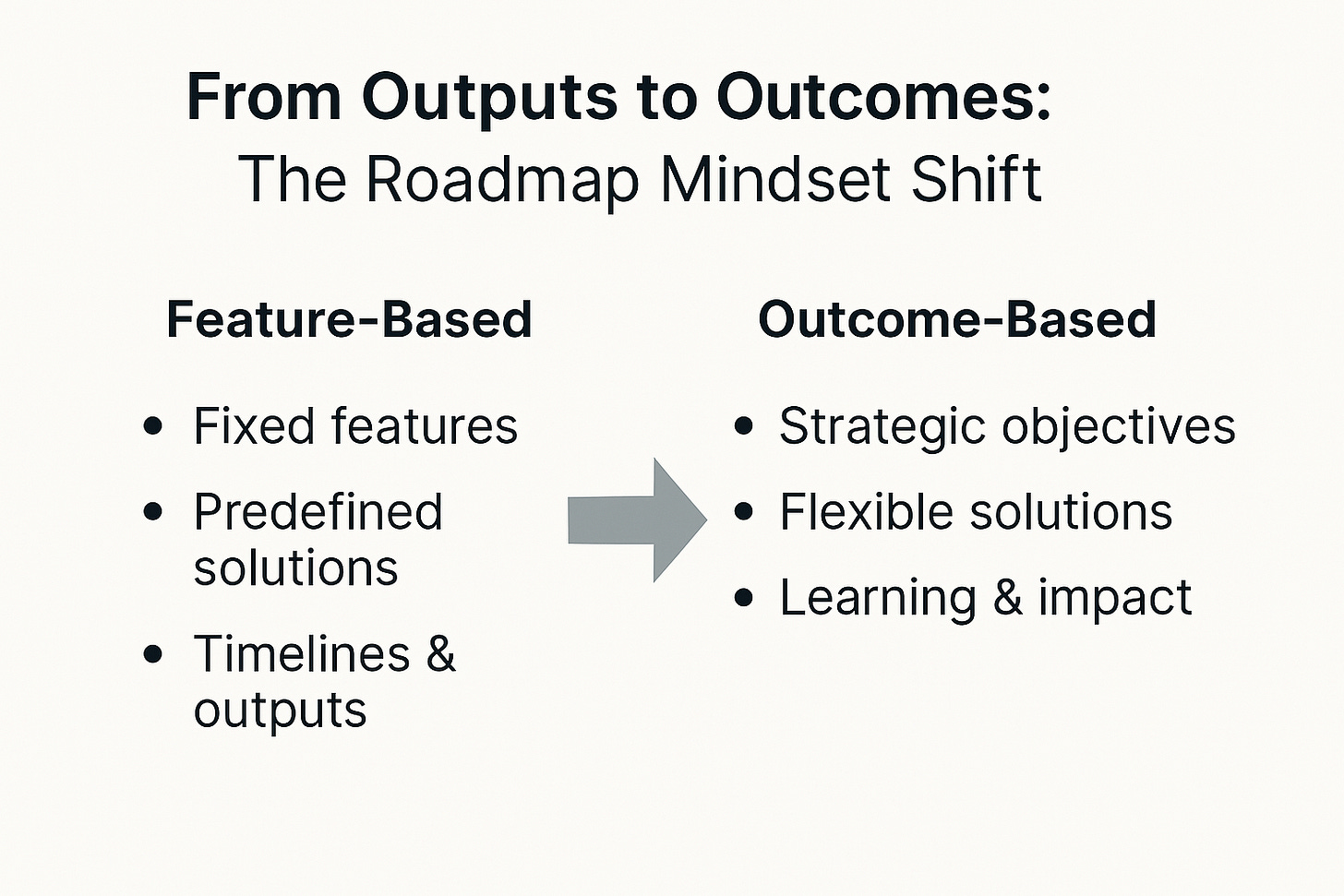Exiting the Roadmap Rut
Why feature-based plans fail - and how to build flexible, outcome-driven roadmaps that actually deliver impact
Too many roadmaps are just release calendars. Here's how to turn yours into a strategy weapon that drives real business outcomes.
🎧 Now a Podcast Conversation
This article sparked a dynamic discussion on The Product Leader’s Playbook, where two AI hosts explore the pitfalls of feature-led planning and how to turn your roadmap into a strategic advantage.
→ Listen on Spotify | Listen on Apple Podcasts
💡 The Moment I Knew Our Roadmap Was Broken
I was staring at a beautifully formatted roadmap, full of milestones and Gantt-style timelines. Every box was filled. Every sprint was spoken for.
But something felt off.
We had shipped every item on the roadmap last quarter... and churn still went up.
That’s when it hit me: our roadmap wasn’t a strategy. It was a shipping calendar. We were optimizing for activity, not impact.
It’s a common trap. I call it the Roadmap Rut – when teams get so focused on what they’re building and when, they forget to ask why.
🧭 From Shipping Lists to Strategic Leverage
Traditional roadmaps look clean and reassuring. But when used the wrong way, they become:
A checklist of outputs instead of a plan for real change
A political artifact shaped by pressure, not problems
A false sense of certainty in a world that demands adaptability
If your roadmap isn’t designed for learning and discovery, it’s working against you.
🚧 The Problem With Feature-Based Planning
You might be stuck in the Roadmap Rut if:
You measure success by what shipped, not what changed
Teams feel locked into delivery commitments from months ago
Stakeholders are asking for deadlines, not insights
Discovery and iteration are treated as distractions
This model falls apart because:
Customer needs evolve. Static roadmaps don’t.
Shipping doesn’t equal value.
Time spent building the wrong thing is time you’ll never get back.
Great teams treat the roadmap as a living, strategic tool. It’s there to align, adapt, and help everyone focus on what matters.
🔄 Shifting the Mindset: From Outputs to Outcomes
The most important shift is mental.
Stop asking, “What are we building next?”
Start asking, “What are we trying to achieve?”
An outcome-driven roadmap is:
A strategy tool, not a shipping list
A learning engine, not a delivery schedule
A communication device, not a calendar
Ask these questions instead:
What outcomes are we driving?
How will we measure success?
What’s the most effective path to get there?
🛠 How to Build an Outcome-Driven Roadmap
Here’s the playbook:
Define clear objectives. Be specific. “Improve UX” isn’t an outcome. “Reduce onboarding drop-off by 20 percent” is.
Tie initiatives to measurable results. Use OKRs, KPIs, or North Star metrics to track real impact.
Allow flexibility in execution. Don’t lock teams into solutions. Give them space to experiment and learn.
Organize by themes, not features. Group work by problems you’re solving, not widgets you’re shipping.
Communicate trade-offs. Help stakeholders understand what you’re not building – and why.
🔁 From Features to Outcomes: Make the Shift Clear
Replace these feature-based items with outcome-driven goals:
Launch new pricing page in Q2 → Increase paid conversions by 25%
Build mobile notifications → Improve daily active use by 15%
Redesign dashboard UI → Reduce task completion time by 30%
These outcome statements do more than reword.
They give teams the space to explore, experiment, and deliver what actually moves the needle – not just what was planned.
🧩 Three Roadmap Formats That Actually Work
1. Now-Next-Later Model
A simple format built around timing and confidence:
Now – High-confidence initiatives already in motion
Next – Validated ideas being scoped or planned
Later – Big bets that still need exploration
Helps teams stay focused without locking into artificial deadlines.
2. Objective-Led Roadmap
Start with a strategic goal, then align all work to it:
Example:
Objective: Reduce churn by 15 percent
Initiatives: Improve onboarding, add proactive support tools
Prioritize: Based on expected impact and feasibility
Helps stakeholders connect the dots between product and business goals.
3. Thematic Roadmap
Group initiatives by customer needs or growth levers:
Improve Activation – onboarding, aha moments, habit loops
Increase Retention – loyalty programs, nudges, community
Drive Expansion – referral systems, upsell paths, cross-sell
Keeps focus on outcomes while allowing space to experiment.
🧠 Overcoming Stakeholder Resistance
Yes, you’ll get pushback. But most objections can be reframed. Here’s how:
Objection: “We need to know what’s launching and when.”
Reframe: “We’ll give visibility into current work, plus clarity on when we’ll make our next decisions. This builds transparency without forcing false certainty.”
Objection: “Leadership wants a feature list, not vague goals.”
Reframe: “Our goals aren’t vague. We’re being specific about the outcomes we’ll deliver and how we’ll measure success.”
Objection: “Customers asked for this. Why aren’t we committing?”
Reframe: “Customers want solutions, not specs. We’re focused on the underlying need and finding the best way to meet it.”
This shift isn’t about being ambiguous. It’s about being strategic.
🧭 A Roadmap Should Be a Strategic Narrative
A good roadmap tells a story. It shows:
Where we’re going
Why it matters
How we’ll know we’re making progress
It’s not a set of promises. It’s a tool for making smarter decisions, faster.
The best roadmaps don’t predict the future. They help you learn your way into it.
✅ Final Takeaways
A roadmap is not a shipping schedule. It’s a strategy map.
Measure success by outcomes, not activity.
Organize your roadmap around learning, not launching.
Stakeholders don’t just want visibility. They want confidence you’re solving the right problems.
Outcome-driven planning isn’t a process tweak. It’s a competitive edge.
🎧 Want to Go Deeper?
This article is also available as a podcast episode on:
🎙 The Product Leader’s Playbook – streaming everywhere:
🔹 YouTube | Amazon Music
💬 Your Turn
Have you ever been stuck in the Roadmap Rut?
What helped your team shift from output to outcome?
Drop your thoughts in the comments; I’d love to hear your story.



